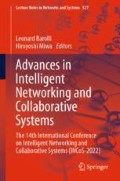Abstract
Nature always inspires through the behavior of its living things. Living things with various advantages, instincts, and individual characteristics to survive following the natural conditions. One is fungi, the eukaryotic organism known as mushrooms. They come from spores carried by the wind, insects, animals, or other living things. Then the spores found a suitable place to grow through the spread and vines. In this paper, we propose a fungi network simulation adapted to nutrient distribution behavior in the underground environment. Fungi have unique activities. Animals or other living things in the world digest their food inside of their body, whereas fungi digest food outside of their body so that it is easy to absorb. Therefore the fungi will grow suitably in the food source’s environment, and the spreading growth of the fungi will adjust to the substrate. If there are no nutrients, the network will not occur, and the fungi branch called mycelium will not grow in that direction. The mycelium of the fungi will determine the growth direction according to the nutrient number obtained. Based on the growth of fungi in the real world, we developed a simulation of fungi growing in a virtual environment. The result we expect at this simulation stage is to be able to compare growth rates based on colonization density against substrates between fungi. Furthermore, for the next plan, we can build a complete network system within the framework of a communication system that becomes a reference for implementation in the real world.
Access this chapter
Tax calculation will be finalised at checkout
Purchases are for personal use only
References
Wikipedia. Fungus. https://en.wikipedia.org/wiki/Fungus. Accessed 31 May 2022
Carris, L., Little, C., Stiles, C.: Introduction to fungi. Plant Health Instructor (2012)
Yuvaraj, M., Ramasamy, M.: Role of fungi in agriculture, chapter 6. In: Mirmajlessi, S.M., Radhakrishnan, R. (eds.) Biostimulants in Plant Science. IntechOpen, Rijeka (2020)
Lifesciences1abookv1
Sheldrake, M.: Entangled Life: How Fungi Make Our Worlds, Change Our Minds & Shape Our Futures. Random House Publishing Group (2020)
Varjani, S.J., Patel, R.K.: Fungi: a remedy to eliminate environmental pollutants. In: Prasad, R. (ed.) Mycoremediation and Environmental Sustainability. FB, pp. 53–67. Springer, Cham (2017). https://doi.org/10.1007/978-3-319-68957-9_4
Meyer, V., et al.: Growing a circular economy with fungal biotechnology: a white paper. Fungal Biol. Biotechnol. 7(1), 1–23 (2020)
Bonfante, P., Genre, A.: Mechanisms underlying beneficial plant-fungus interactions in mycorrhizal symbiosis. Nat. Commun. 1(1), 1–11 (2010)
Yang, L., Park, D., Qin, Z.: Material function of mycelium-based bio-composite: a review. Front. Mater. 8, 374 (2021)
Read, D.J.: The mycorrhizal mycelium. In: Mycorrhizal Functioning, pp. 102–133. Chapman and Hall, New York (1992)
Levin, S.A.: Self-organization and the emergence of complexity in ecological systems. Bioscience 55(12), 1075–1079 (2005)
Song, Y.Y., Zeng, R.S., Xu, J.F., Li, J., Shen, X., Yihdego, W.G.: Interplant communication of tomato plants through underground common mycorrhizal networks. PloS One 5(10), e13324 (2010)
Achatz, M., Kathryn Morris, E., Müller, F., Hilker, M., Rillig, M.C.: Soil hypha-mediated movement of allelochemicals: arbuscular mycorrhizae extend the bioactive zone of juglone. Funct. Ecol. 28(4), 1020–1029 (2014)
Beiler, K.J., Simard, S.W., Durall, D.M.: Topology of tree-mycorrhizal fungus interaction networks in xeric and mesic Douglas-fir forests. J. Ecol. 103(3), 616–628 (2015)
Messier, C., Puettmann, K.J., David Coates, K.: Meta-networks of fungi, fauna and flora as agents of complex adaptive systems. In: Managing Forests as Complex Adaptive Systems, pp. 147–178. Routledge (2013)
Simard, S.W., Beiler, K.J., Bingham, M.A., Deslippe, J.R., Philip, L.J., Teste, F.P.: Mycorrhizal networks: mechanisms, ecology and modelling. Fungal Biol. Rev. 26(1), 39–60 (2012)
Li, S.: How does the internet work? (2018)
Sun, B., Zhang, X., Wu, H.: Extending linden scripting language on OpenSim. In: 2012 19th Asia-Pacific Software Engineering Conference, vol. 1, pp. 488–492 (2012)
Delp, S.L., et al.: OpenSim: open-source software to create and analyze dynamic simulations of movement. IEEE Trans. Biomed. Eng. 54(11), 1940–1950 (2007)
Kenton, W.: What is a Monte Carlo simulation? (2022)
Fungus - Nutrition – britannica.com. https://www.britannica.com/science/fungus/Nutrition. Accessed 19 May 2022
Kobae, Y.: Dynamic phosphate uptake in arbuscular mycorrhizal roots under field conditions. Front. Environ. Sci. 6 (2019)
Varela, F.G., Maturana, H.R., Uribe, R.: Autopoiesis: the organization of living systems, its characterization and a model. Biosystems 5(4), 187–196 (1974)
Author information
Authors and Affiliations
Corresponding author
Editor information
Editors and Affiliations
Rights and permissions
Copyright information
© 2022 The Author(s), under exclusive license to Springer Nature Switzerland AG
About this paper
Cite this paper
Sirimorok, N., Paweroi, R.M., Arsyad, A.A., Köppen, M. (2022). Fungi Network Simulation for the Study of Communication Systems. In: Barolli, L., Miwa, H. (eds) Advances in Intelligent Networking and Collaborative Systems. INCoS 2022. Lecture Notes in Networks and Systems, vol 527. Springer, Cham. https://doi.org/10.1007/978-3-031-14627-5_46
Download citation
DOI: https://doi.org/10.1007/978-3-031-14627-5_46
Published:
Publisher Name: Springer, Cham
Print ISBN: 978-3-031-14626-8
Online ISBN: 978-3-031-14627-5
eBook Packages: Intelligent Technologies and RoboticsIntelligent Technologies and Robotics (R0)

